PROTECT YOUR DNA WITH QUANTUM TECHNOLOGY
Orgo-Life the new way to the future Advertising by AdpathwayCoffee grounds are a free garden resource for us coffee drinkers and one more reason to enjoy our morning ritual. But they might not be the most useful in the way we think (or read online). When it comes to coffee grounds for dahlias, they have benefits when applied in the right ways and quantities. But before we go scattering the daily grind, it’s important to know how not to use coffee grounds around dahlias.
Dahlias are a prize of summer with their diverse flower structures in various forms, from tall, towering stems to compact and bushy. Their perfect petal arrangements, whether intricately symmetrical, pompon, or spectacularly informal, delight season after season. Their blooms are too precious to risk by adding something we think is helpful, but might not be.
Treat coffee grounds as you would any other soil amendment, with a moderate approach and a bit of research. Because coffee grounds for dahlias aren’t a tried and true horticultural amendment, it also takes a bit of experimentation. We’ll cover ways to use the grounds for the most benefit, as well as those that are “iffy” and unreliable for dahlias.
Wittem Dahlia Bulbs

Deutschland Dahlia Bulbs

Orange Nugget Dahlia Bulbs
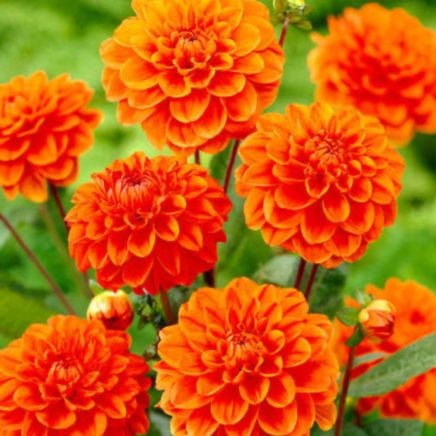
Orange Nugget Dahlia Bulbs
Setting Dahlias Up For Success
 Keep dahlias well-hydrated for best performance.
Keep dahlias well-hydrated for best performance. Dahlias start as tubers (nubby bulbs) that reawaken after winter dormancy to emerge in spring’s warming temperatures. The fleshy, starchy roots sprout roots and shoots from “eyes.” Dahlias perennialize in zones 7-10, where they overwinter in the ground. They don’t withstand frigid winters, and even in zone 7, gardeners may opt to lift them to guard against winter conditions. Where not hardy, dahlias perform well as annuals, growing quickly in a single season.
Cool night-time temperatures and warm days are best for dahlias to grow and flower. On average, 55-60°F (13-16°C) night-time temperatures and 70-80°F (21-27°C) daytime temperatures are ideal. While heat-loving, the long, hot, humid summers of the lower South are challenging.
After planting, dahlias have a long time to flower, taking about 100 days. For cold climates with short growing seasons, pre-sprouting or starting them indoors in pots gives them a head start toward growing and flowering. For gardeners in warm climates, planting post-frost with staggered timing yields lovely later-season blooms.
Situate sun-loving dahlias where they’ll ideally receive six or more hours of daily sunlight. In climates with intense summer sun, provide afternoon shade protection. Dahlias are almost 75% water and need plenty of consistent moisture throughout the growing season. With loose, crumbly, loamy soils that are rich and well-draining, the blooms will be off to the races.

The Role of Coffee Grounds
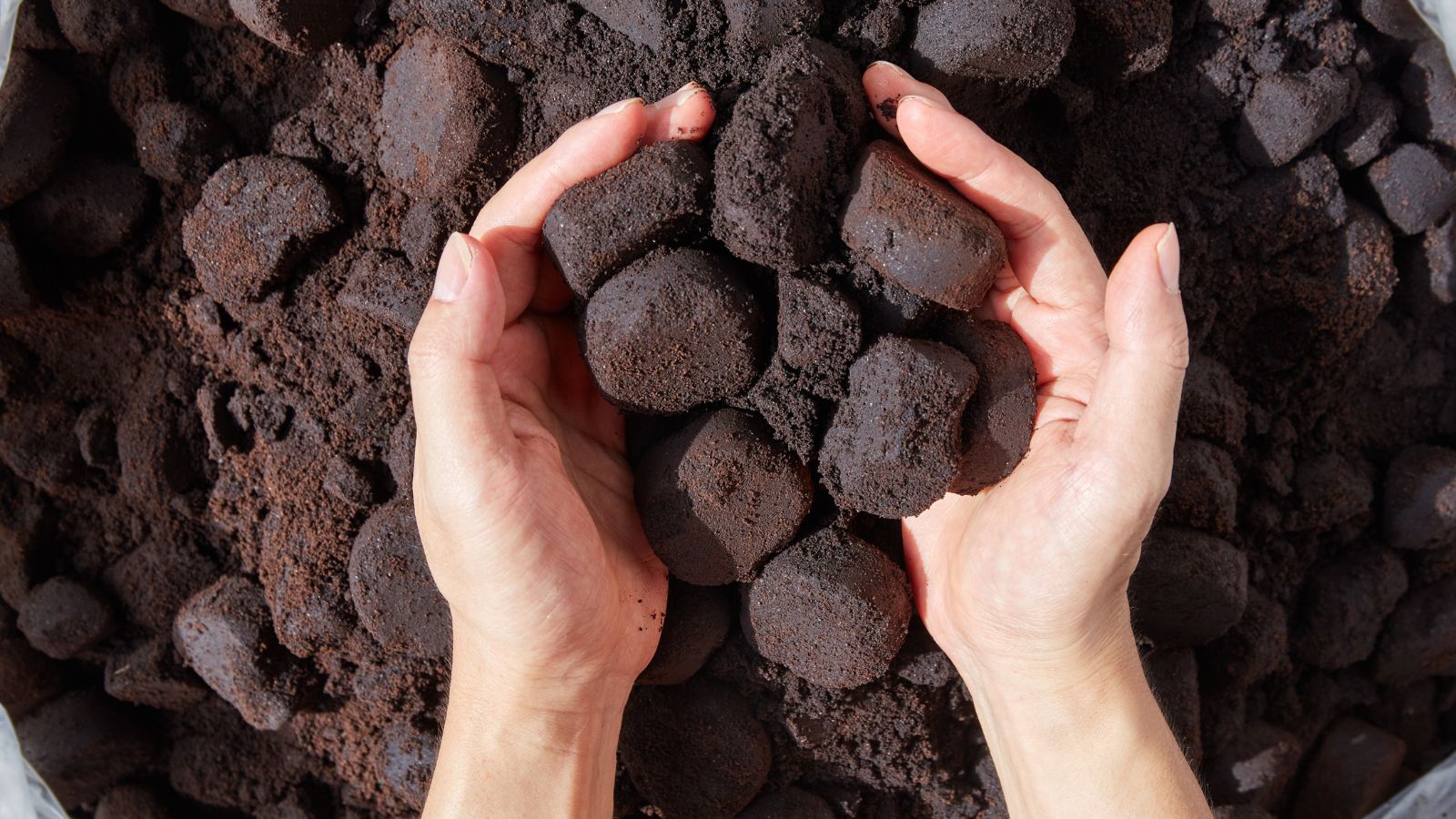 Use only brewed coffee grounds as a soil amendment.
Use only brewed coffee grounds as a soil amendment. Coffee grounds are often touted as a beneficial amendment, usually with scattering or working in the grounds on the soil surrounding the plant. This has the most merit in targeted applications, rather than a general broadcast. An excess of grounds causes stunted growth and yellowing and is not worth risking around dahlias.
Use only brewed coffee grounds as an amendment. The hot water brew reduces the potency of caffeine and other components that may be harsh on roots.
Coffee grounds contain 1-2% nitrogen and minor amounts of phosphorus, potassium, calcium, and magnesium. They also contain very small amounts of other trace minerals, nutrients, and carbohydrates that plants need for healthy growth.
Unreliable Applications
Coffee grounds hold benefits for dahlias in the realm of improving soil structure through compost or a slightly dug-in amendment. The key is moderation and avoiding enthusiastic overages in repurposing the grounds.
Raising Soil Acidity
 Dahlias may appreciate the slight increase in acidity levels from coffee grounds.
Dahlias may appreciate the slight increase in acidity levels from coffee grounds. Dahlias prefer slightly acidic soils and do best with a pH between 6.5 and 7.0. Coffee is acidic, and can slightly lower the pH/raise the acidity level in the application area. Coffee grounds are a fit to use around dahlias since a temporary boost in acidity won’t be harmful. Brewed coffee grounds actually match dahlias’ pH needs, with a slightly acidic to neutral level near 6.5 to 6.8.
The caveat is that brewed coffee grounds aren’t as acidic as we might expect, and won’t consistently maintain a lower soil pH. Their acidic-to-neutral pH impact is short-lived, running its course soon after application.
A soil test is always a good idea when it comes to determining soil pH and nutrient deficiencies. If your soil runs alkaline (higher pH), amend with garden lime in the fall. Combine occasional coffee grounds with an oak leaf or pine needle mulch to slightly raise acidity as they decompose. If the foundation is too acidic, raise the pH with garden sulfur. Amending in the fall gives the soil time to absorb and process the elements to benefit roots as they grow in the spring.
As Fertilizer
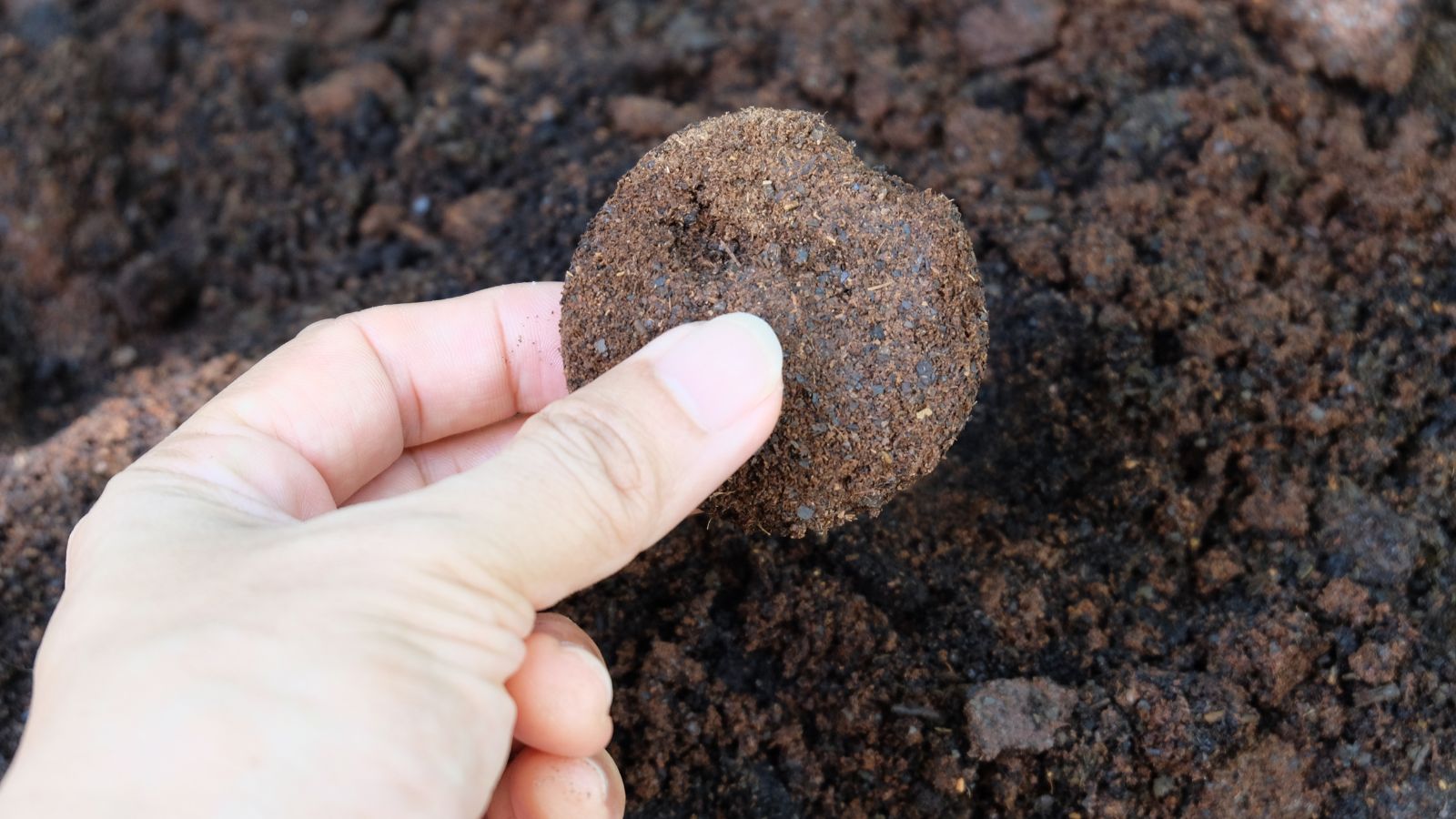 Coffee grounds can add minor nutrients but are not a fertilizer substitute.
Coffee grounds can add minor nutrients but are not a fertilizer substitute. Coffee grounds add minor amounts of essential nutrients to dahlias. They won’t harm the perennials in moderation, but they’re also not a singular fertilizer substitute. Nutrient-rich soils are the best foundation for dahlia blooms. Coffee grounds can contribute, especially in compost (more on that below).
Soil microbes quickly consume the nitrogen from coffee grounds – a good thing – but an additional source is necessary to reach the dahlia roots for uptake. The micronutrients in the grounds also aren’t a major source of plant nutrition.
Dahlias grow quickly and use a lot of energy to produce their showstopping blooms. They benefit from an all-purpose organic fertilizer at planting and from monthly feedings until mid-August when growth slows. Or, opt for a slow-release granular to distribute nutrients gradually over about two months, requiring fewer applications. A 5-10-10 or 5-20-20 organic fertilizer helps boost blooming without sending too much nitrogen into leaf and stem production. A mild organic option is alfalfa meal to supplement coffee grounds.
As Mulch
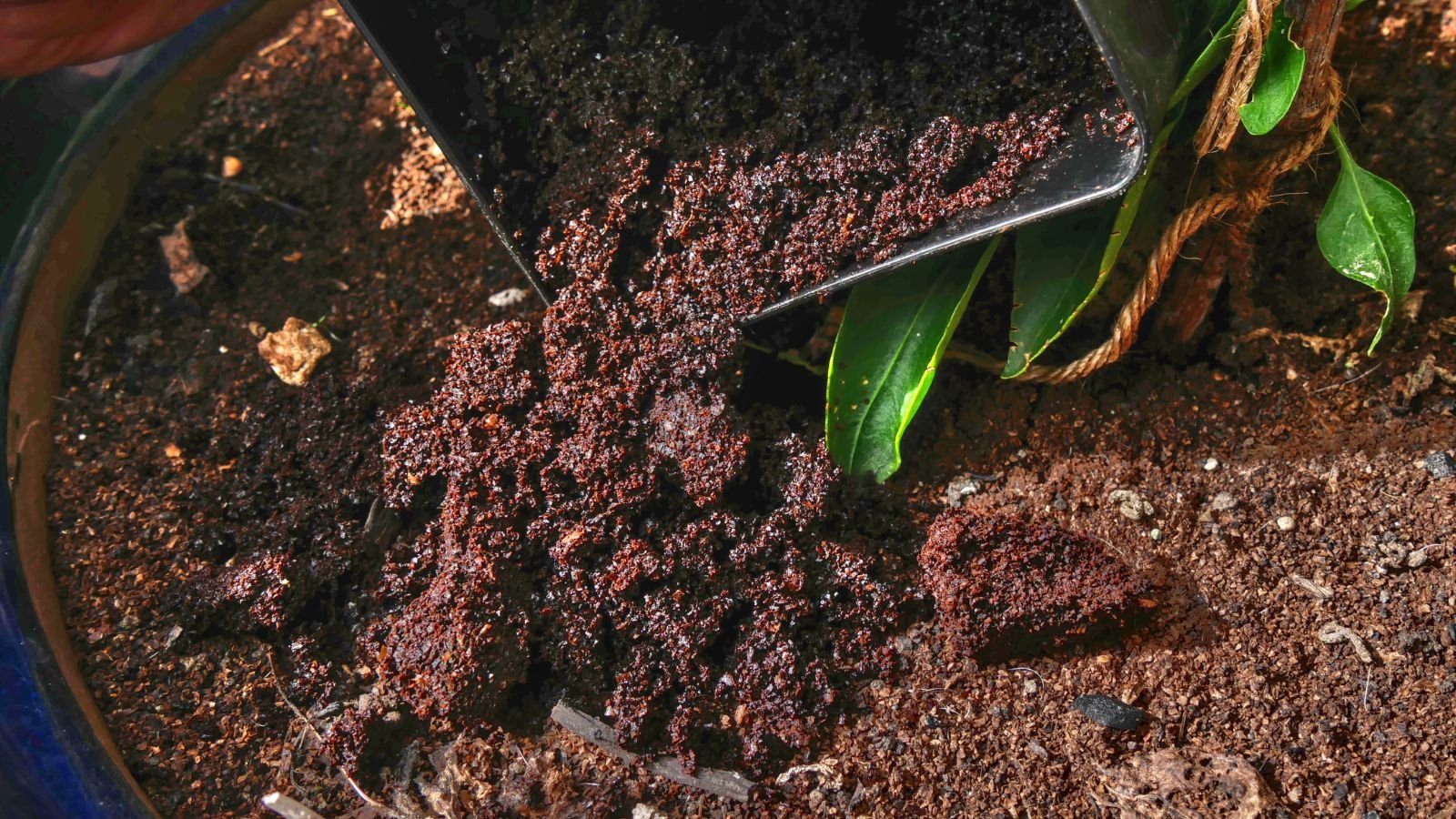 A very thin layer of coffee mulch is okay, but a thick layer may repel water.
A very thin layer of coffee mulch is okay, but a thick layer may repel water. Don’t plan to use coffee grounds as a thick mulch around dahlias. If using them as a topdress, apply a thin layer (¼ inch to ½ inch thick), keeping it away from the stems and crown.
If they dry out, the grounds become hydrophobic and actually repel water rather than absorb it without sufficient rehydration. Dahlias need evenly moist soils for the best vigor, without a layer hampering absorption. To use them as a surface application, top them with a layer of pine straw, leaves, or bark chips to keep them from drying out and aid in overall moisture retention.
Beneficial to Dahlias
Now to the nitty gritty of how best to use coffee grounds for dahlias. The most reliable means is to improve soil structure, especially with compost.
Compost
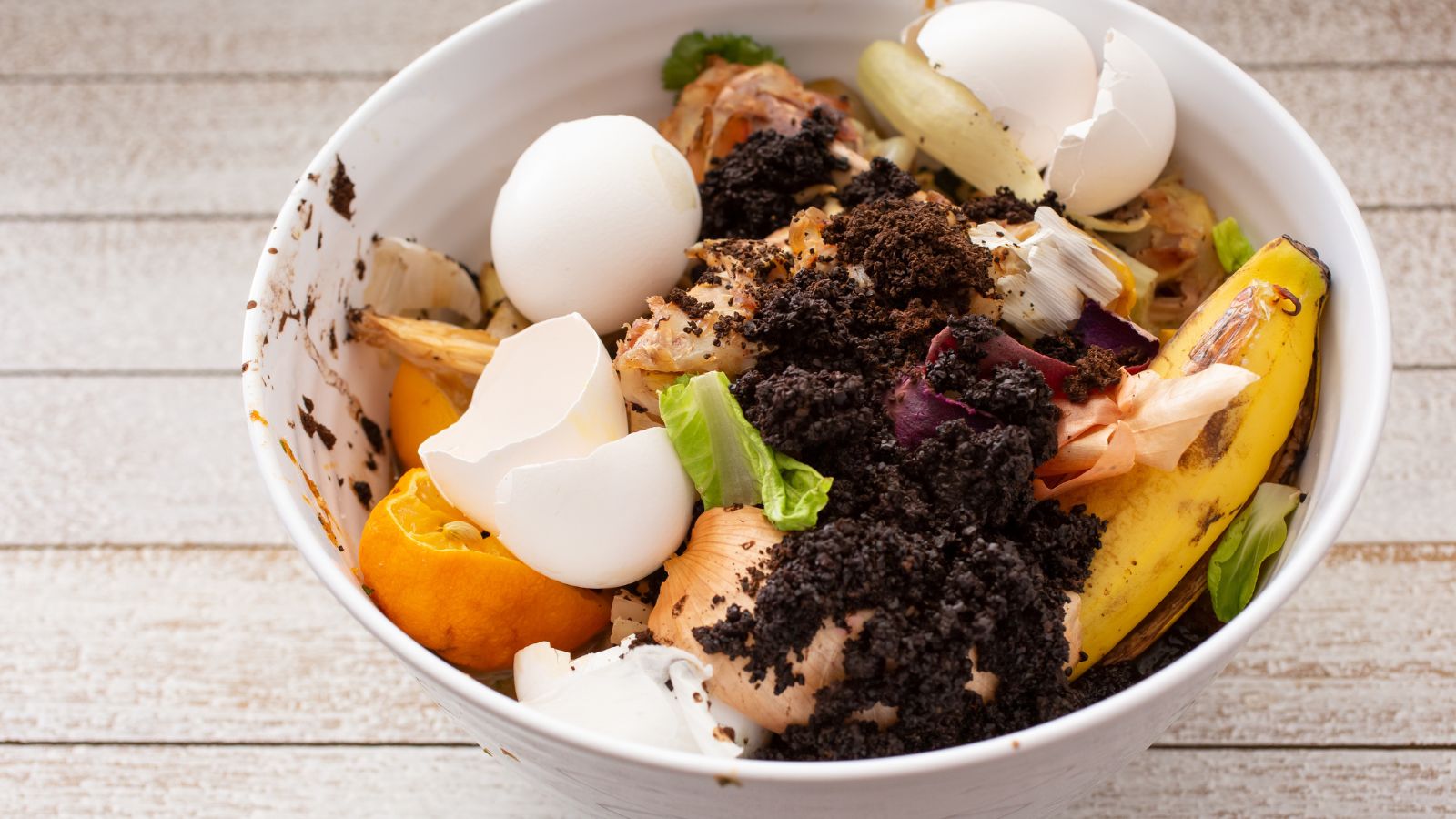 Compost your grounds for the best results.
Compost your grounds for the best results. Composting the grounds is the most beneficial way to incorporate coffee into the garden. The result of allowing the grounds to decompose over three to six months with balanced organic matter offers the best in aiding soil nutrition, moisture retention, and aeration. They’re a rich food source for beneficial microbes that make quick work of converting them to nutrition for root absorption.
Add the spent grounds (coffee filters, too) to the bin or pile, matching the quantity with sufficient greens and browns. For one part coffee, add one part greens like grass clippings and three parts browns like leaves.
The whole composition should be a balance of browns and greens, and no more than 20% coffee grounds. With too many, it becomes toxic and counteracts the results we hope to achieve with enriched soils.
Coffee grounds show benefits with vermicomposting, too, where worms convert them to nutrient-dense “black gold.” We need more research on the impacts of coffee on the worms; again, moderation is key.
Improve Soil Structure
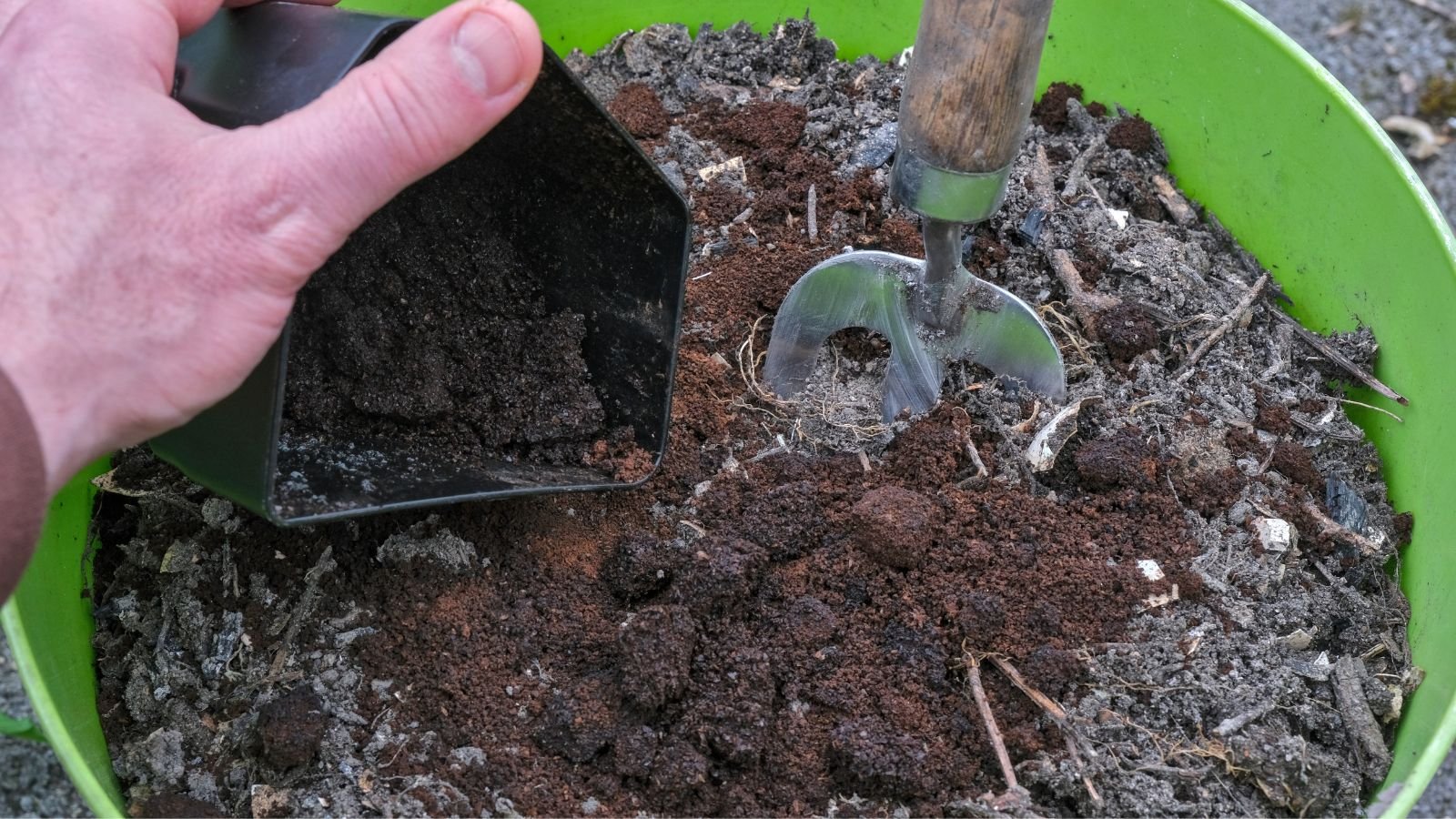 Work grounds less than an inch into the top layer of soil.
Work grounds less than an inch into the top layer of soil. To apply the grounds as a soil amendment, work ¼ to ½ inch into several inches of soil surrounding the perennial. Do this once or twice a season to measure results in your garden. Soil microbes work on breaking down the nitrogen and carbohydrates to improve the soil structure and root access to nutrients.
Pest Deterrent
 Caffeine may deter slugs from your flowers.
Caffeine may deter slugs from your flowers. Coffee grounds may benefit dahlias as a slug deterrent. The pests are unwelcome visitors that enjoy the plants as much as we do, especially young shoots and buds. There are two primary ways to experiment with coffee as a slug repellent: with the grounds or as a liquid soil or foliar drench.
Studies show that the caffeine in coffee can reduce slug presence and kill them through ingestion. A small percentage of caffeine (1-2%) with water kills slugs and keeps them away from the area. Make a soil drench by using 2 parts of strong brewed coffee to one part water and pouring it around the plant’s perimeter. As a foliar spray, use 9 parts water to one part brewed coffee. Apply to a test area first and observe the leaves for a couple of days before spraying the whole perennial.
To employ the grounds, try a small ring six to eight inches from the crown. Slugs don’t prefer to crawl across rough and unstable grains, especially caffeinated ones, and may avoid the passage.


 3 weeks ago
29
3 weeks ago
29





















 English (US) ·
English (US) ·  French (CA) ·
French (CA) ·